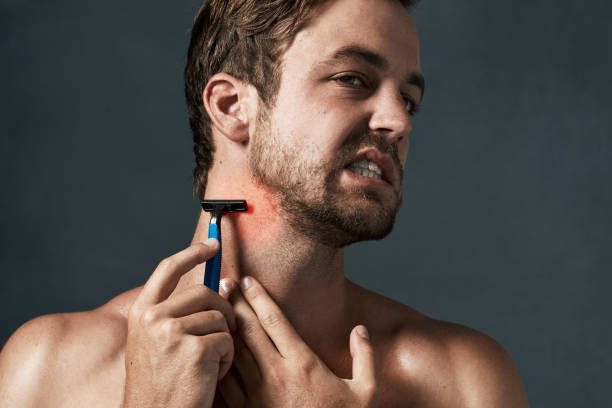This content is for informational and educational purposes only. Always consult a qualified healthcare provider.
Last Updated on January 18, 2024 by Grace Oluchi
Razor burn can be a frustrating and uncomfortable experience, but with the right knowledge and techniques, it can be avoided and treated. In this guide, we’ll answer the top 5 FAQs about razor burn, from what causes it to how it can be prevented and treated. So, let’s dive in and say goodbye to razor burn for good.
📋 Table of Contents
Razor Burn.
Razor burn is a skin irritation that can occur after shaving. It can be caused by shaving too closely, using a dull razor, shaving too quickly or roughly, using hot water, or not using shaving cream or gel. The symptoms include;
- Redness.
- Itchiness.
- Bumps.
- Small cuts or bleeding.
It can be uncomfortable or painful, but it usually goes away on its own within a few days. To prevent it, you can use a sharp razor, shave in the direction of hair growth, use shaving cream or gel, and avoid shaving too closely or quickly.
Causes of Razor Burn.
Razor burn is usually caused by one or more of the following factors:
- Using a dull blade: A dull blade can irritate the skin and cause razor burn.
- Shaving too quickly: If you shave too quickly, you are likely to miss hairs and go over the same area multiple times, which can irritate the skin.
- Using hot water: Hot water can dry out the skin and make it more susceptible.
- Shaving against the grain: Shaving against the grain can cause the hair to be cut too short, which can lead to ingrown hairs and razor burn.
- Not using shaving cream or gel: Shaving cream or gel helps to lubricate the skin and prevent it.
- Sensitive skin: Some people have skin that is more sensitive to shaving and is more prone to razor burn.
Treatment for Razor Burn.
Here are some tips for treating it:
- Apply a cool compress: A cool compress can help to reduce redness and soothe the skin.
- Apply aloe vera: Aloe vera has anti-inflammatory properties and can help to reduce redness and soothe the skin.
- Use hydrocortisone cream: Hydrocortisone cream can help to reduce inflammation and itching.
- Avoid shaving: If possible, avoid shaving the affected area until the razor burn has healed.
- Moisturize: Moisturizing the skin can help to keep it hydrated and reduce the severity of it.
- Use a topical antibiotic: If the razor burn is severe or has become infected, a topical antibiotic can help to clear up the infection.
- Use over-the-counter pain relievers: Over-the-counter pain relievers like ibuprofen or acetaminophen can help to reduce pain and inflammation.
Remember, the best way to treat it is to prevent it from occurring in the first place. Use a sharp razor, shave in the direction of hair growth, use shaving cream or gel, and avoid shaving too closely or quickly.
More About It.
Razor burn is a common skin condition that can occur after shaving. It is characterized by redness, swelling, and a burning or stinging sensation. It can occur anywhere on the body where hair is removed, but it is most common on the face, neck, legs, and underarms.


Its severity of can vary from person to person and can range from mild to severe. In some cases, razor burn can lead to small cuts or even bleeding. In addition to the physical discomfort, it can also be unsightly and can cause embarrassment.
To prevent it, it is important to prepare the skin properly before shaving. This can be done by washing the area with warm water and soap to remove any dirt or oils that may be on the skin. Applying a pre-shave oil or gel can also help to soften the hair and make it easier to cut.
The Key Takeaway.
When shaving, it is important to use a sharp razor and to shave in the direction of hair growth. Shaving against the grain can cause the hair to be cut too short, which can lead to ingrown hairs and razor burn. Using a shaving cream or gel can also help to lubricate the skin and prevent it.
If you do experience razor burn, there are several treatments that can help to reduce the symptoms. Applying a cool compress or aloe vera can help to reduce redness and soothe the skin. Using a hydrocortisone cream or over-the-counter pain reliever can also help to reduce inflammation and relieve pain. In severe cases, a topical antibiotic may be necessary to clear up an infection.
What is razor burn?
Razor burn is a common skin condition that occurs after shaving, causing redness, irritation, and sometimes small bumps.
What causes razor burn?
It is typically caused by improper shaving techniques, such as using a dull razor or shaving too quickly. Other factors that can contribute to it include dry skin, shaving against the grain, and using harsh products.
How can razor burn be treated?
Razor burn can be treated with over-the-counter creams and lotions that contain anti-inflammatory ingredients such as aloe vera or hydrocortisone. It’s also important to avoid shaving the affected area until it has healed and to use gentle, moisturizing products.
Can razor burn be prevented?
It can be prevented by using proper shaving techniques, such as using a sharp razor and shaving in the direction of hair growth. It’s also important to properly prepare the skin before shaving and to use gentle, moisturizing products.
When should I see a doctor for razor burn?
While it is usually a minor skin condition, it can sometimes lead to more serious complications such as infection. If it does not improve with at-home treatments or if you notice signs of infection such as pus or fever, it’s important to seek medical attention.

